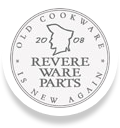Here is a small snapshot into inflation. Consider this play Revere Ware set from a 1977 Sears catalog.
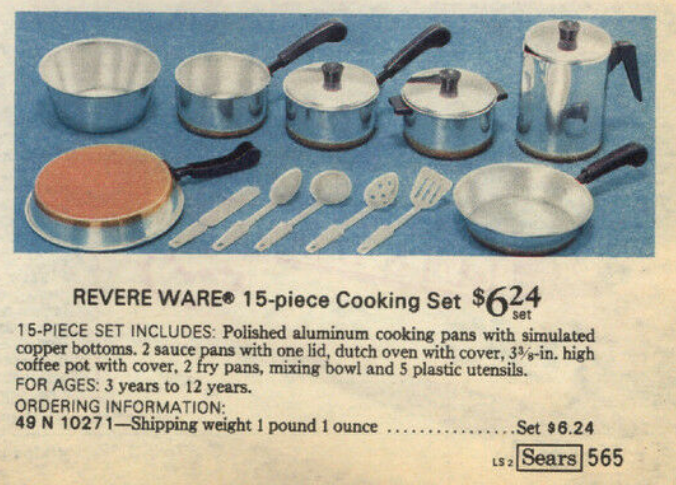
It is hard to imagine a play set like that selling for $6.24 when you consider what that can buy today (a Starbucks Latte or thereabouts).
Here is a small snapshot into inflation. Consider this play Revere Ware set from a 1977 Sears catalog.

It is hard to imagine a play set like that selling for $6.24 when you consider what that can buy today (a Starbucks Latte or thereabouts).
This has got to be the most surprising Revere Ware product I’ve seen yet, an instrument sterilization tray.
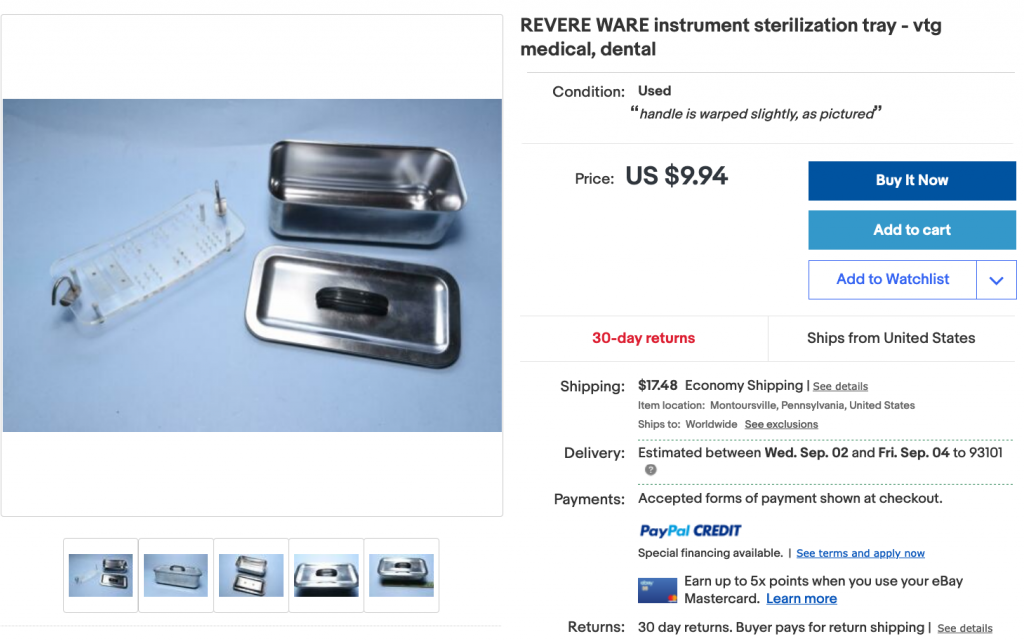
It’s definitely Revere Ware:
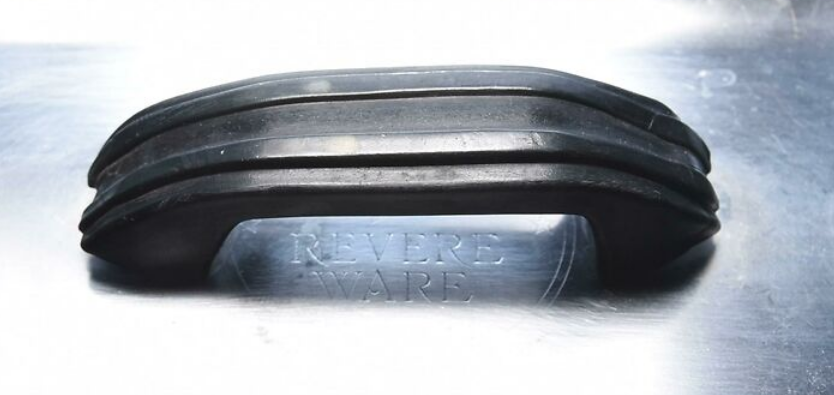
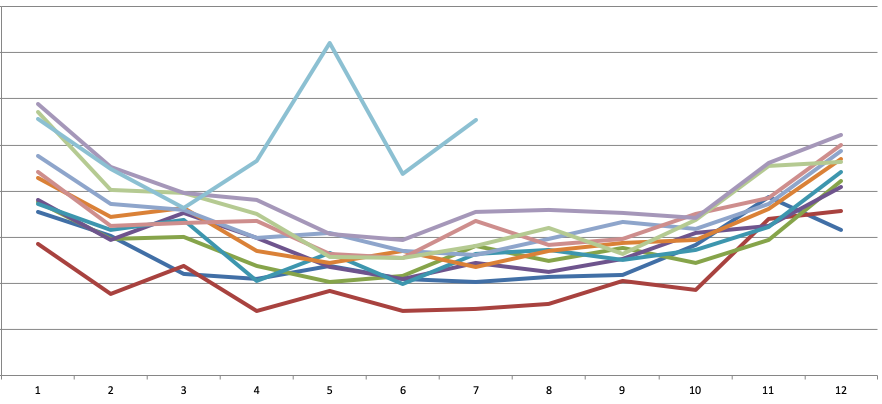
Well, here we are in the 5th month of the pandemic. Since April, we’ve seen a boost to sales as people spend more time (a lot more time) at home cooking, and are likely wanting their cookware to be in tip top shape.
May was our best month ever, in 11 years, and was 2 1/2 times our normal May volume.
June slowed down somewhat, but was still 1 1/2 times our normal June.
But July picked up significantly again and was about equal to our busiest month of the year, January, and was almost double our typical July.
The sad news is, the trend in July is probably happening because the coronavirus is again running rampant, worse than it ever has, and people are once again hunkering down and spending less time going out, and more time cooking in.
In this sense I guess we are just one more dashboard into how the country is feeling about the coronavirus.
As we’ve discussed before, 70% of our sales are through Amazon.com, up from none in 2009. Amazon.com has capture more and more of our sales, something through aggressive tactics like advertising against our own website through Google AdWords. And there’s been a lot of news in the last couple of months about Amazon.com using its position as a third party marketplace to glean data to become a competitor for some of the top selling products.
Besides all that, how is Amazon.com for consumers? My personal experience is that I continue to practice higher and higher levels of caution when shopping on Amazon.com, and I continue to look for more reliable alternatives for some of my purchase categories.
So what’s the problem?
About 10 years ago Amazon.com started courting Chinese sellers aggressively to help fill up their marketplace. Because of multi-national agreements on postal service costs, shipments from China can often be shipped for less than the cost of shipping within the US, very often far less. My guess is that our average postage cost for shipping first class packages within the US is about $4.00. Many shipments from China can be shipped from China to their final destination in the US for a third of that. That gives Chinese sellers a significant advantage. So theirs that.
But if you’ve had any experience dealing with companies in China, they work from a different rule book; dishonesty seems much more common and is considered acceptable by many. It is not uncommon for employees in China to arrange for two invoices when dealing with vendors, one of which shows an inflated price and one shows the real price; the employee pockets the difference. It is also common for vendors to fake material certifications and substitute inferior materials.
So it doesn’t come as much of a surprise that a huge increase in Chinese sellers now selling on Amazon.com brings with it a lot of problems, like:
Fake products
Perhaps 3 or 4 years ago I bought some Apple earbuds off of Amazon.com; they were cheaper than on Apple.com and had stellar reviews. What arrived were so obviously inferior and stopped working after a short while.
Inferior products
The prevalence of Chinese sellers on Amazon.com means that a majority of pretty much any category of item you are looking for will be really cheaply made and marginally functional items.
Fake reviews
I think 2 or 3 years ago the fake reviews started in earnest. At first it was really obvious stuff, like 3,000 identical 5-star reviews on a product all added on the same day, or reviews done in really bad English. But as time when on, it got more sophisticated. In addition to realistic looking completely fake reviews, sellers routinely simply pay shill buyers to buy their product and give it a positive review, and then reimburse them for the cost. I’ve received cards with purchases from Amazon.com offering to refund the purchase price for a positive review, so they are pretty bold about trying to recruit people.
Brushing
You might be familiar with the brushing scam from all the unsolicited seeds that have been sent to people in the last couple of months. Apparently this scam involves sellers using fake accounts to buy their own products, then mailing them to unsuspecting people. They do this to ensure they can write positive reviews for their own products, thereby giving their items a boost in Amazon’s search results.
Account takeovers
We’ve even heard of unscrupulous sellers registering trademarks and then using them to claim that they own a seller account, thus taking it over from the legitimate account owner. They then start selling inferior knockoffs from the account to capitalize on the brand (and in the process ruining the brand).
Fake competitor reviews
Some sellers will intentionally add obviously fake reviews to a competitors product so that the product gets banned by Amazon.com. Or they will leave negative reviews to drag the overall rating down. This means that it is harder to tell the good products from the bad ones.
Help?
I’m sure there are more I’ve missed. After reading all this you might be thinking that Amazon.com is a wasteland and you should stay far, far away from buying anything there. You might not be too wrong. So what can you do?
Use a review filtering service
First and foremost is to use a review service and / or plugin like FakeSpot or ReviewMeta to get a clearer picture of products and sellers. These services use artificial intelligence to (try and) weed out the real reviews from the fake ones. It isn’t uncommon to see a 4 1/2 start rating get restated to a 1 1/2 star one after the bogus reviews are filtered out. They also rate sellers from A (good) to F (very bad) based on how many of the reviews are fake. I no longer buy from sellers that don’t have a B or better rating.
Buy from people you already know
If you are happy with a product, buying it again from the same seller isn’t a 100% guarantee, but is pretty close. A lot of what we do is repeat buying.
Distinguish between safe
Buy elsewhere
A lot of big retailers are getting their e-commerce act together and are great places to buy things now. Personally, I am trying to move a lot of my purchases away from Amazon.com as I just don’t like supporting a retailer that has created and supports so much pandemonium on their marketplace.
Here are some of my favorites.
Walmart.com has free 2-day delivery on lots of items and items can be shipped to a nearby store for pickup for free.
Target.com can ship things to a nearby store for free and get 2-day free delivery for orders over $35. We are lucky enough to have a small footprint Target nearby that isn’t too busy.
B&H Photo Video has an astounding deal for tax-free purchases, especially important for us as the sales tax in our state and town is almost 9% now. If you sign up for their PayBoo credit card, any purchases you make with it will automatically refund you the tax, effecting a tax free purchase. I make all of my large electronics purchases from them now, like the new iPads we just got for our kids for the coming (remote learning) school year.
Yes, we sell on Amazon.com
As mentioned above, about 70% of our sales volume is on Amazon.com. But you can trust our listings on Amazon.com for one really good reason – we are the only company that sells what we sell. No-one else offers Revere Ware replacement parts and I seriously doubt anyone would go through the trouble to knock off the parts to start selling inferior versions given that our product is somewhat niche and doesn’t have huge sales volumes.
Reader Nedra contacted us with a pot that had boiled dry with water and left black stuff all over the bottom.
Hello, I have a 2 quart pan that I left on the stove too long. The water that was in the pan completely
evaporated and left the bottom of the pan black. What do you recommend to clean with? I am so
upset….one of my favorite go-to pans.
Sometimes heavy hard water deposits, which you will always have some of when you boil a pot dry, can get charred black like this. Regardless of what it is, the best approach I’ve found is heating up some vinegar and powdered dishwasher detergent. I have no idea why powdered is better than liquid, but that is what I’ve always used and it works.
We first tried this when my wife was making simple syrup (sugar and water) and boiled the mixture dry. That smoked quite a bit and brought the fire department, as we had smoke detectors through our alarm company. The firefighters were pleasant and somewhat amused.
Given the rock hard layer it left behind, we thought the pan was a goner. But lo and behold, repeated heating and scraping with a flat metal spatula got most of the stuff off and a green Scotch Brite pad took care of what remained. But that’s not the only method. Here is what Nedra did:
Thank you for getting back to me so soon. I did put baking soda and apple cider vinegar, that’s all I had on hand. I left it over night and it seems to be lifting a little bit. I’ll buy straight vinegar today.
And then:
First I coated the pan with oven cleaner and left it on overnight, nothing. Then I added baking soda and white vinegar and let that sit for a few hours. Did it again but this time heated the pan. I used a steel wool pad with soap and elbow grease and low and behold I have my shiny pan back I’ve attached before and after photos for you.
Now, a couple of words of warning here. Oven cleaner can cause pits in your stainless steel so is not recommended. Steel wool can leave little bits of itself behind which will promote rust. It is best to stick with a Scotch Brite pad for scouring and, if you want a bit more of a polish, use Bar Keepers Friend.
But, don’t use a Scotch Brite pad on the outside of your cookware as it will dull the finish. On the inside, this is ok as the finish gets naturally dulled by acidic foods and metal cooking utensils. Bar Keepers Friend however is good for both the inside and outside of your stainless steel cookware and is a great way to bring back some of that shine.
I think the largest downside to the discontinuation of the production of new Revere Ware is the iconic tea kettle. While the quality of Revere Ware suffered in the last 3 or 4 decades, new tea kettles hadn’t changed much in ways that made them less useful. I’ve used both vintage era Revere Ware kettles and new ones, and they all functioned about the same for me.
But they can eventually fail, requiring replacement, and with no new production, that has become harder. So it is notable when we see a reasonably priced replacement kettle, especially one that is new in the box (NIB), as this one, which has a starting bid + shipping of under $40, not far off the price they once were new, just a few years ago.
Reader Eileen contacted us this week with an inquiry about her Bakelite handles emitting a foul odor:
I use my Revere pots and pans daily. Today, while making my younger children mac n’ cheese, the handle to the pot started to melt. The chemical smell caused us to evacuate the house for several hours.
This presents a good opportunity to talk about safely using cookware with Bakelite handles.
The biggest danger to Bakelite handles is a gas stove. If a small pan is put on a large burner such that the flames, or the heat licks up the sides, it will cause the Bakelite to fail and emit this foul odor. Bakelite is a phenolic plastic; it doesn’t melt when overheated, it breaks down into its constituent parts, one of which is formaldehyde, which is the foul odor Eileen smelled. Despite the potential risk for this type of failure, we hear very few reports of this type of problem.
However, one issue is that, as Bakelite becomes older and damaged, it will fail through overheating much easier. Repeated washes in a dishwasher can cause damage that will make Bakelite much more susceptible to overheating. We did a dishwasher test and have shown that it doesn’t take a lot of repeating washings in the dishwasher for the handles to show visible discoloration, a prelude to the type of damage that can make them more sensitive to overheating.
The other risk to Bakelite is using pieces with Bakelite in an oven. You might think a Dutch oven was intended for the oven, and when Revere Ware first started selling their iconic cookware they did offer it as oven safe. But some time later they reversed their position and no-longer suggested it was such.
Bakelite is safe up to 35o degrees F, for a limited time. But modern ovens can often have hotter spots within them, especially when they are heating up. We don’t offer our parts as oven or dishwasher safe.
So our three safety tips for the day for cookware with Bakelite handles are:
We continue to get requests for help with the problem of the metal handle spline separating from the body of a cookware piece, like this:
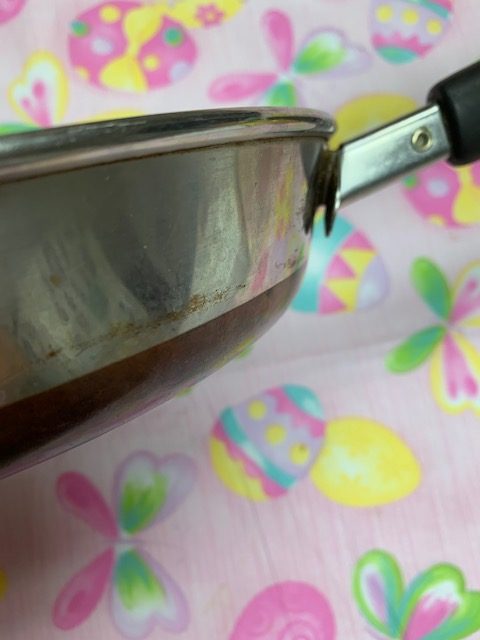
So we thought we’d summarize the best information we have on this problem in a single blog post.
Option 1: spot weld it back on
You can find out blog post on spot welding here.
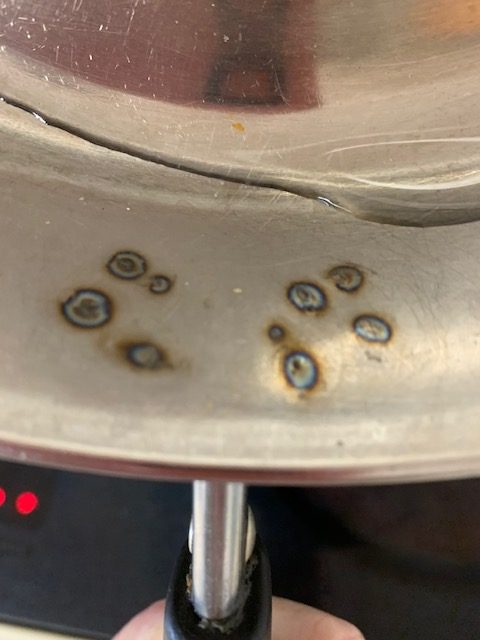
When we talked to welders, they felt that the cookware metal was too thin for a good spot welding result. But it has been done with success, so perhaps they were wrong. It also might matter if your cookware is older, pre-1968, which has a thicker stainless steel, versus newer cookware, which can be quite thin.
Option 2: Braze it back on
You can find our blog post on brazing here.
Brazing is like soldering; heat up both pieces of metal and flow a melted metal wire between them to permanently attach them.
The results are not flattering, but it works.
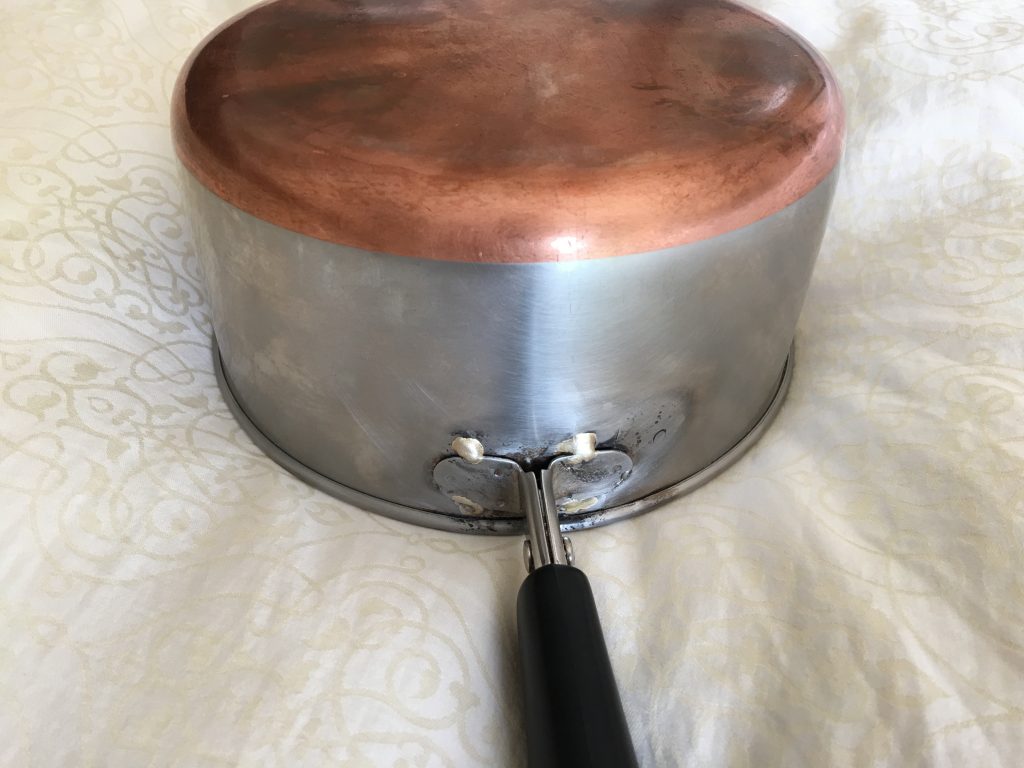
Option 3: bolt it back on
You can find our blog post in screwing the handle back on here.
Perhaps the least aesthetically pleasing of the options, but the simplest.
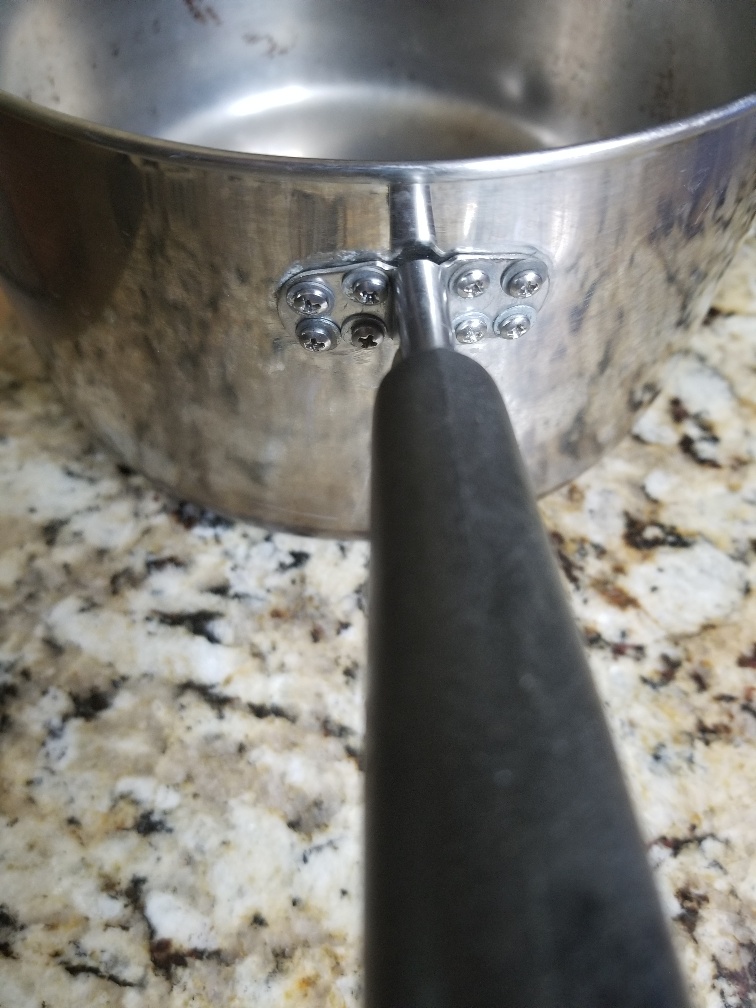
As people spend more time cooking and more time using their vintage Revere Ware, we’ve gotten a lot more requests recently for Revere Ware warranty service, some of them quite demanding. People seem to skip right past the disclaimer on our contact form an other places on our site.

Hopefully people will find this post and it will help clarify the situation.
The Revere Ware brand has bounced around among several corporate owners since the 1980’s. They continued to offer some warranty support until 2018, when the latest corporate owner, Corelle Inc, shuttered the brand and discontinued all warranty support. So unfortunately warranty support for Revere Ware is now a thing of the past.
In contrast, we are a totally separate company that came on the scene in 2009 and started offering a selection of replacement parts to help you get your cookware in good operating order again, and a lot of helpful Revere Ware related materials.
And we are happy to try to answer just about any question you might have about Revere Ware. But unfortunately, we can’t replace your broken cookware or provide you with free replacement parts for original Revere Ware cookware under their warranty.
We do however stand by our replacement parts; if you have a problem with them, please don’t hesitate to contact us.
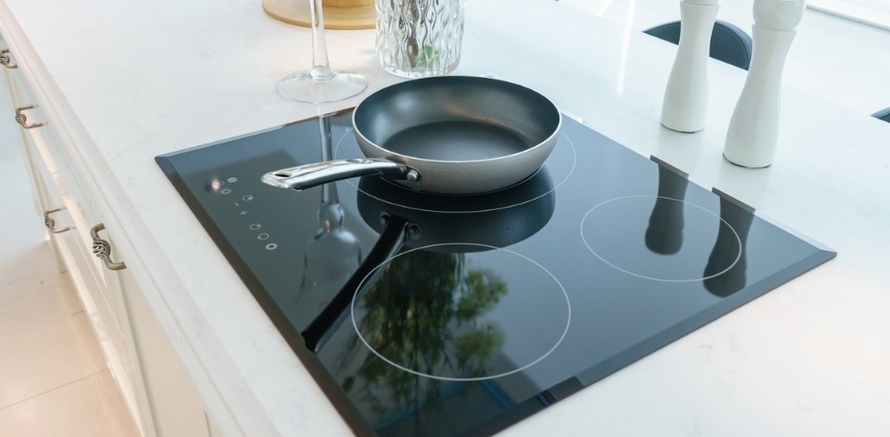
Some people like the look of glass top stoves. Personally, my wife and I prefer gas cooking as it we find it much more responsive than anything electric. But what if you do have a glass top stove? Can you continue to use your Revere Ware cookware? Reader Mellanie asks:
I received my set of Revere ware in 1967 as a wedding gift from my parents. The pans are in great shape, as is my marriage, and I still use them every day! My problem is that we bought a new stove this year with a glass cooktop and the pans are “rounded” on the bottom now and don’t sit flat on the stove top. Any suggestions for me in cooking with them now. They still work, but it takes longer to cook things. It doesn’t seem to matter much how heavy the contents being prepared is while cooking.
Sadly, you likely can’t (or shouldn’t) use your Revere Ware copper bottom cookware with glass top stoves. For starters, flat surfaces like glass stoves are less than ideal with warped cookware. In addition to the lower heat transmission, they can often warble on the stove by themselves, which I personally find really annoying.
But the best argument against using Revere Ware is that copper can stain a glass stove top. According to GE Appliances:
Copper Bottom pans are also good, but they can leave residues on the cooktop that appear as scratches. These can be removed if cleaned immediately, but do not let a copper-bottom pan boil dry. An overheated copper pot will leave a residue that will permanently stain the cooktop.
Who among us has not accidentally left a pot to boil dry, so this poses a real risk.
Sadly, it is probably best not to use Revere Ware on glass top stoves.
